Varieties of scarlet and its cultivation

Knowledge of the varieties of scarlet and the characteristics of its cultivation is quite interesting for any gardener. Having dealt with the "Rising Sun" and Chinese cercis, majestic and carob, other types and varieties of wood, their description, it will be possible to obtain the optimal effect. Separately, it is worth considering the use of this plant in the garden and near the house.
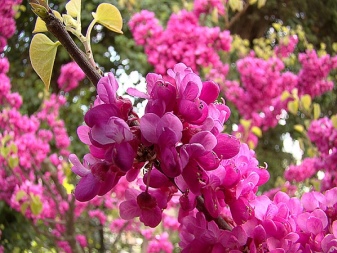

Description
The scarlet, aka cercis, is a deciduous culture. Both trees with a height of more than 17 m and shrub forms are known. A black-brown bark forms on the trunk. Its cracking is fully consistent with the norm. The shoots of the first year of development are painted in a reddish tone, and if the plant has been developing for several years, then they have an olive-brownish color with a gray tint. The leaves are distinguished by a simple, solid structure. They are characterized by a round or ovoid configuration. The venation is finger-like. Spiral arrangement is characteristic. Small stipules are linear and fall very early.
The flowers of the scarlet are always irregular, grouped in brushes or in bunches. They can even appear on the trunk (this is a characteristic feature of caulifloria). The corolla has a moth-like structure. Calyx in the form of a wide, moderately oblique thickened bell with short blunt teeth. Cercis fruits belong to the category of beans, they are flat in shape, contain from 4 to 7 flat, rounded seeds.

Flowering continues until leaves appear. It should be noted that this culture also has the common name "gingerbread tree". And it was not given in vain. When the leaves turn yellow and wither, an unusually pleasant aroma spreads in the air. It is in it that the notes of muffin are caught.
The scarlet grows sometimes in rather difficult conditions. Two species of this genus have adapted to the Pamir-Alai, Afghanistan and the mountainous regions of Turkmenistan. The appearance of cercis in the Shvanidzor gorge in Transcaucasia was noted.
All these plants are extremely thermophilic. Therefore, their cultivation in Russia is very difficult, which, however, is only a daring challenge for an experienced gardener; all that remains is to find out what and how can be grown.
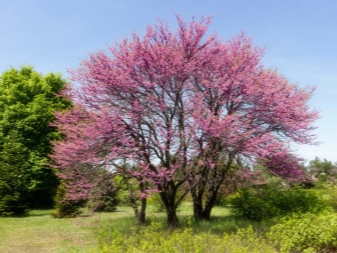
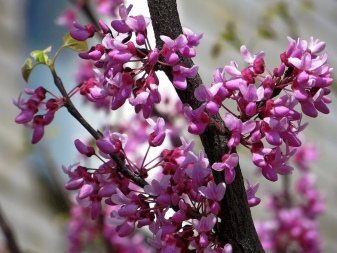
Popular species and varieties
Canadian
The spectacle of this bush growing and blooming would be a worthy decoration for a surrealist painting. But in Russia, original plants do not take root well. Yes, frost-beaten specimens come to life with proper care, but they will no longer bloom. Recently, breeders have been working on such a problem. So far, the practical application of these plants is out of the question.
There are such main varieties as:
- Forest Pansy (with purple-burgundy leaves);
- Pink Pom Poms (giving gorgeous pink flowers);
- Ruby Falls (featuring weeping shoots and dark purple foliage);
- "Rising Sun" - so named for the characteristic impression of flowers.
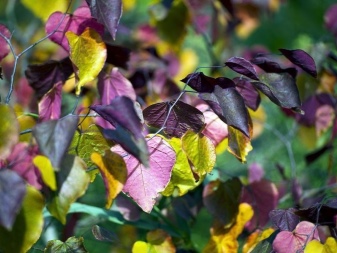
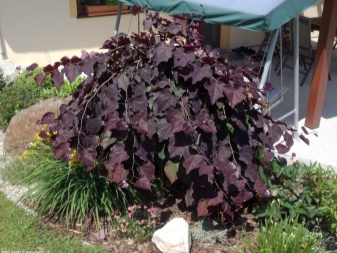
Chinese
The deciduous shrub is extraordinarily beautiful. The maximum height of the trunk can reach 15 m. Branching and subsequent bizarre curvature of the branches are characteristic. The flowers look beautiful and have an irregular shape, the smell is not typical for them. The length of the beans appearing in August reaches 0.11 m.
You can see this plant as much as possible in the Mediterranean.

Qin
This species, too, could reasonably be called "Chinese" due to its origin. The height of the bush varies from 2 to 6 m. A smooth light gray bark is formed on the trunks. Characterized by a dense leathery structure of the beans. Inflorescences are typical of old shoots.
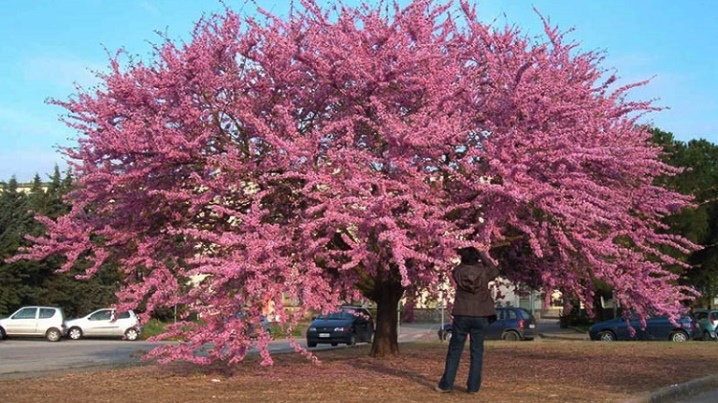
Griffith
The height of such plants is no more than 1-4 m. In nature, they are found in the Afghan, Iranian and Central Asian mountains. Hence the extreme form of adaptation. Branching is very active. The beans ripen throughout the summer.
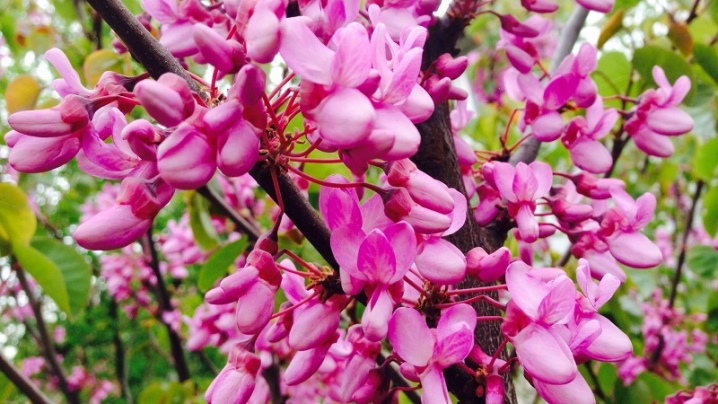
West
This type of cercis is common in the southwestern United States. Thin chestnut shoots shine expressively. The leaves are shaped like a heart. During the growing season, they darken, and in cold autumn they turn red and acquire a golden hue. The faded plant produces thin brownish pods.
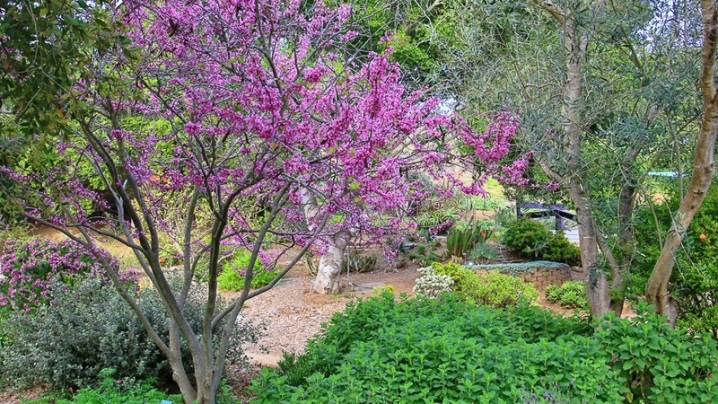
Naked
This species has practically no horticultural significance. Like other members of the genus, it refers to:
- bean family;
- a detachment of leguminous plants;
- class of dicotyledonous plants.
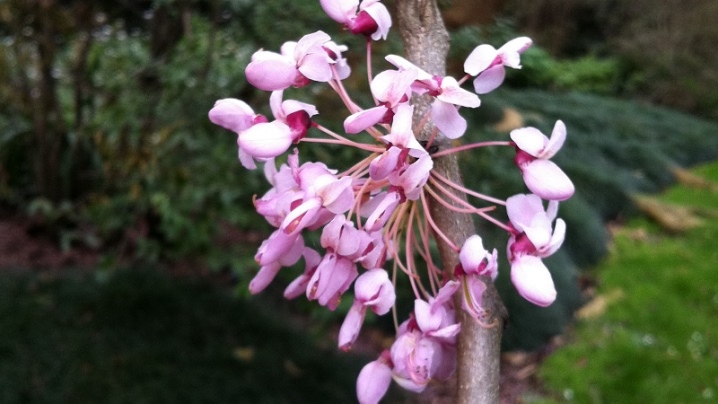
European
This species has the common name "Judas tree". In nature, such bushes can be seen on the Black Sea coast of the Russian Federation. The culture is drought tolerant. However, it needs excellent insolation. The height varies from 7 to 15 m, and the bark reaches almost complete black.
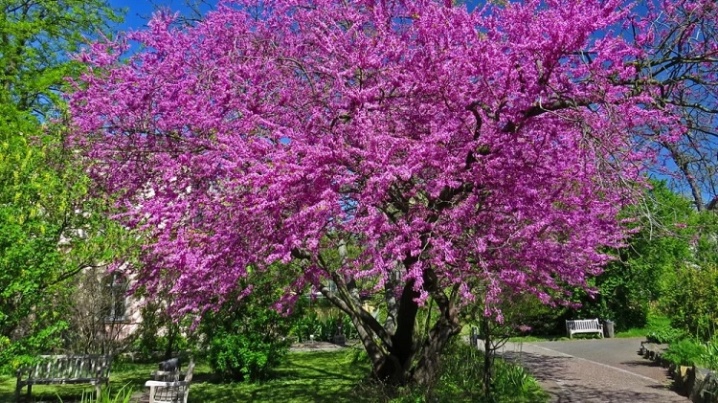
Other
The majestic cercis is considered by many to be a variety or subspecies of the Japanese group. It develops mainly in the mountains. In terms of decorative properties, the plant is at least not inferior to other varieties. The foliage looks no less graceful than the flowers. In the autumn months, the culture exudes a vanilla-ginger aroma. The carob type - aka a tree with a flowering trunk - is still the same European species, only under an alternative name. The same can be said about "ordinary" and "bush" epithets.
Of the specific varieties, the following are deservedly popular:
- "Pink Charm";
- Pinkbud;
- "Silver Cloud";
- Ruby Falls;
- "Flame" (does not bear fruit).
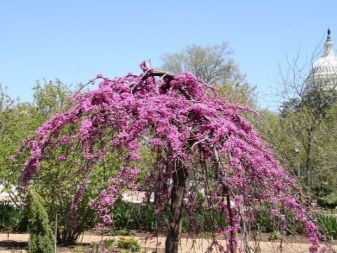
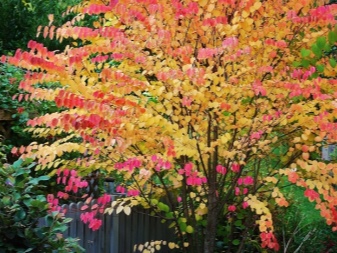
Landing
If there are cuttings with a well-developed root complex, planting is possible in April or May (more precisely, it can be said only by the actual weather). The optimal distance between the bushes is at least 0.15-0.2 m. Cercis develops well on soils with both neutral and acidic reactions. For him, however, the quality of drainage and the saturation of useful components are critical. Lighting is typical for open areas (bright sunlight or soft partial shade). At the very beginning of development and rooting, the land should be watered abundantly. Important: seedlings and young shoots can suffer greatly from excessive sun exposure. It is more correct to plant them at least at first in partial shade.
Regardless of age, cercis is extremely sensitive to piercing cold winds, especially in high humidity - this is important to remember when choosing a place. Be sure to check the occurrence of groundwater. The distance to them should not be less than 2 m. The presence of lime in the soil is encouraged. There are mentions of purple rose successfully grown on strongly acidic and alkaline substrates, but only experienced gardeners and agronomists should experiment with such an extreme. It was found that the shift of the pH towards the acidic side increases the saturation of the foliage color in autumn.
On a new, for the first time put into circulation or for a long time not used, the land should be dug up.
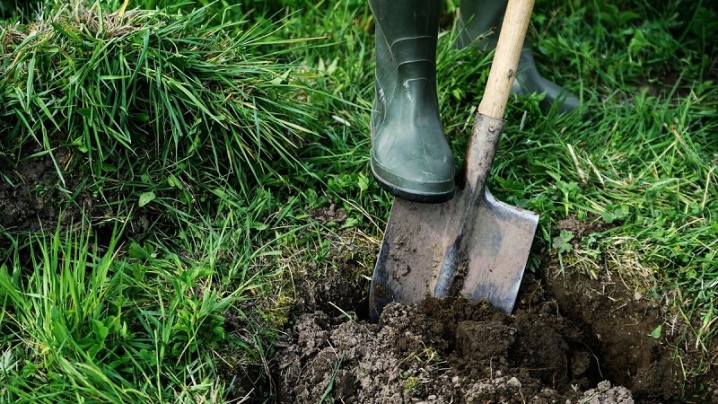
Care rules
Despite the decent drought tolerance of cercis, irrigation is encouraged. Only with its good organization can one count on rapid growth and intense flowering. Young trees and bushes are shed often, abundantly, so that the earth does not dry out. After the plant gets stronger, you can do it less. But you should still focus on the actual weather and the state of the culture. It is usually not required to specially feed the purple bush.
It is very good if fertile land is initially chosen. In the spring and during the summer, small doses of phosphorus, nitrogen and potassium are used. Other recommendations:
- replace individual fertilizers with Kemiru-Universal;
- form a crown in the autumn;
- remove dry or inward branches during formation;
- carry out pruning in the first 3-5 years, then only remove frozen or too old shoots;
- avoid close planting of other plants;
- transplant the culture in the second year and later only when urgently needed;
- mulch the near-trunk zone for the winter;
- to wrap up early growth with the approach of cold weather.
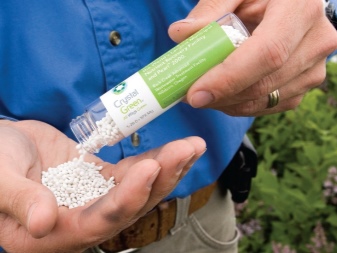

Reproduction
For this purpose, you can use both seeds and cuttings. The seed mass is stratified from the beginning to the end of winter. The procedure goes like this:
- 1 day in boiling water in a thermos;
- drying the swollen seeds on a towel;
- 30 days in a tightly closed package on the lower tier of the refrigerator;
- repeating the entire cycle from the beginning (in total, including the first run, 4 times);
- with the arrival of heat (stable 15 degrees or more) - disembarkation.
Seeds can be sown right in the spring. But only after natural stratification within a year will the shoots appear. Sowing is sometimes carried out in a seedling box. The substrate includes equal shares of turf, washed sand and leafy soil. Cuttings are harvested in the fall (no more than 0.2 m, with 2 or 3 internodes). The shoots are buried in a pot. There should be large fraction of wet sand. Watering - as it dries from above. The rooting temperature is from 20 to 25 degrees, covering with polyethylene is encouraged. Planting in the spring goes into holes up to 0.12 m deep, with a fresh oblique cut at 45 degrees; the hole is watered and mulched.
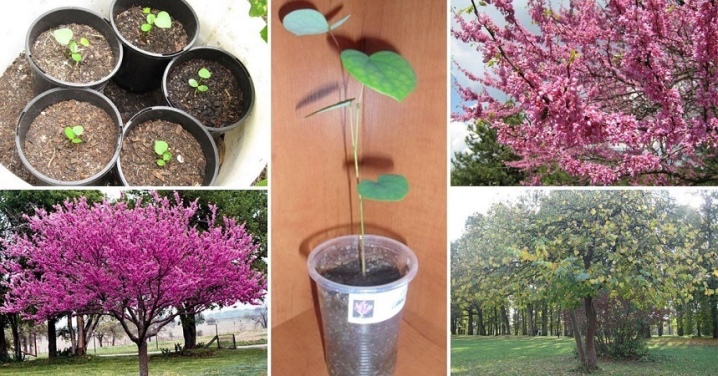
Diseases and pests
Resistance to pathologies and "eaters" is the hallmark of the scarlet. But in many areas, plant freezing is likely. Shelter and mulch can help prevent misfortune. In dry weather, aphids are dangerous for the culture, which are scared away by preventive whitewashing.
To prevent the bush from drying out from anthracnose, periodically its development is anticipated by spraying with diluted Bordeaux liquid.
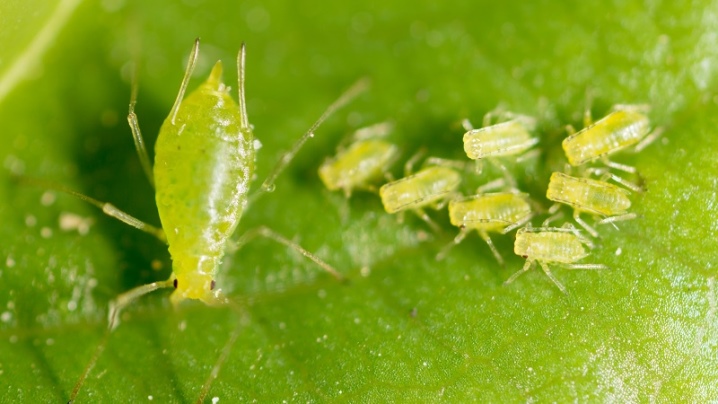
Bagryannik in landscape design
There are many convincing examples of the high aesthetic characteristics of scarlet.
- This is how its Japanese version looks against the background of a brick wall and metal roofing.
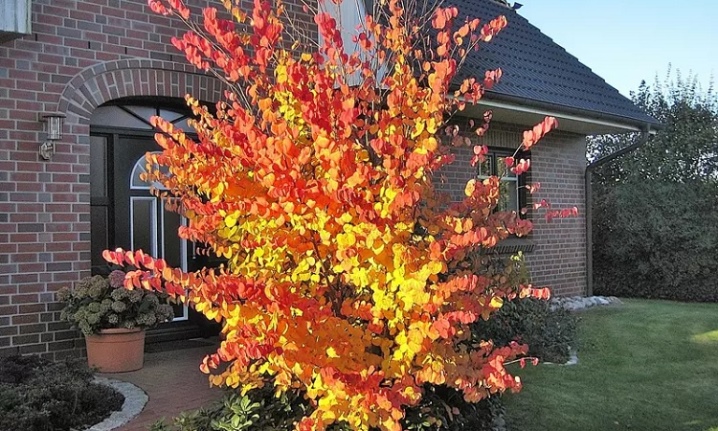
- But this photo reveals all the charm of the Chinese type. The visual merits of the European branch are also shown. It favorably sets off the appearance of a rocky wall and yellow low flowers.


- The best way to reveal the aesthetics of scarlet can be in tree and shrub groups. Since the crown and leaves are the main advantages, the plant should be well visible.
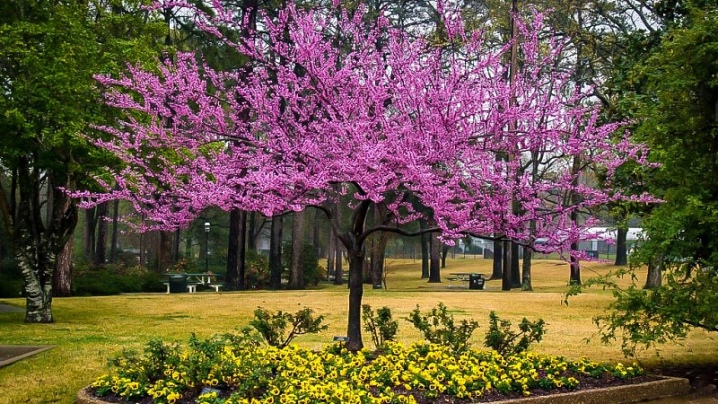
- In private gardens, compact forms of this culture are most acceptable. The style of the garden and the surrounding landscape hardly play any role.
As you can see, there are many reasons to still try to grow this capricious species.
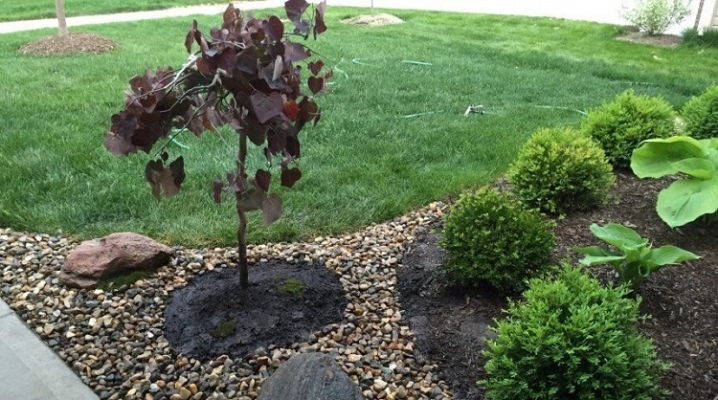
In the next video, you will see the crimson crop trimming in November.





























































The comment was sent successfully.